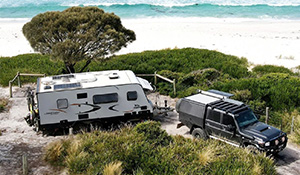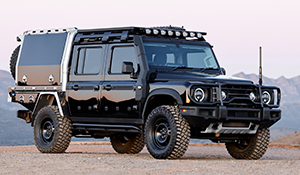2023 Mahinda XUV700 - ROAD TEST
Words and Photos: Fritz Moschitz
The Mahindra XUV700 is a recent arrival in Australia, aimed at our popular and extensive mid-size SUV sector. So, where does this new model sit in Mahindra’s lineup, as well as Australia’s very competitive SUV market generally? After a week with it, I feel like I know exactly where it belongs…

Let me start this review by saying I’m not a full-on off-roader. Just as well, because neither is the XUV700. While Mahindra do offer vehicles that can take you far off the grid, like the PikUp and Scorpio, the XUV700 is made for the urban jungle – an environment it handles exceptionally well.
The first thing to get straight with the XUV700 is that Mahindra refer to it as the XUV ‘Seven Double O’, not XUV ‘Seven Hundred’. Secondly, it’s made in India, but that’s not a negative. For those that think ‘Indian made’ means ‘poorly made,’ park your prejudice. These days, Indian vehicles, like Chinese ones, are as good as anything coming out of Japan, Korea or Europe in terms of build quality and the level of standard appointments.

The third point is that the XUV700 offers incredible value for money. With drive away pricing under $40,000 (an introductory offer that was still valid at time of writing), it’s Australia’s cheapest new 7-seat SUV by some margin. In comparison, rivals like the Nissan X-Trail and Mitsubishi Outlander hit around the $45K mark with on-road costs. The LDV D90 is closer on price, but that’s a full-size SUV and the XUV700 is in the mid-size bracket – an important distinction.
That sub-$40K pricing gets you a lot, but not everything. More on that later.

Note the flush door handles – something you don’t expect to see in a vehicle in the XUV700’s price bracket.
Sharp Style, Sharper Price
Mahindra design has come on in leaps and bounds over the past few years. Against the ungainly-looking PikUp, the XUV700 is from another planet.
The headlight treatment, grille design and styling of things like the lower bumper and mirrors give the XUV700 a “city SUV” look, but with a hint of “I can play dirty,” too. It’s hard to articulate, but it looks like it’d be just as comfortable off the beaten path as it would around town. It’s an illusion, though.
Despite the black plastic cladding on the wheelarches, solid wheel/tyre combo and decent ground clearance (229mm), the XUV00 is only available in front-wheel drive, making it unsuitable for anything challenging off-road.
On the plus side, the XUV700 looks much more expensive than its drive away price, which for the base model ‘AX7’ is $36,990, while the upper grade ‘AX7L’ is $39,990.

The premium look outside ramps up when you take a look inside. There are swathes of white leather-look trim, gloss black accents on the doors, dual 10.25-inch screens for infotainment and instruments, and just the right amount of bright metal detailing. It makes for a very sleek and modern look overall. Cover up the Mahindra badge on the steering wheel and you could easily mistake this vehicle as coming from Volvo or Audi.
If you’re familiar with Mahindra’s predecessor to the XUV700, the XUV500, you’ll know the difference inside is chalk and cheese. The XUV500 dash looked it had pieces tacked on like random LEGO bricks, but every element is much better integrated on the XUV700.
Along with the big leap forward in design, there’s a major improvement in build quality, choice of materials and overall finish, too.

Despite its lux look, especially inside, there is a “practical man’s car’” vibe to the XUV700. It also doesn’t look out of place in any environment – in the city, suburbs or around the edges of the bush. I say “the edges” because with FWD only, road-biased tyres and alloys, you’d want to pick easy trails if you’re taking this thing off-road - and don’t travel alone!
Yes, you could lift the suspension and fit some more suitable wheels and tyres if you were determined to take this SUV into rough terrain, but for the money that’d cost, you’d be better off buying Mahindra’s Scorpio, as it has four-wheel drive and all the off-road chops already built in.

Two to Choose, but One for All
While there are two model grades for the XUV700, there’s only one drivetrain. A 2.0-litre turbo petrol four-cylinder engine producing 149kW and 380Nm, matched to a six-speed automatic driving the front wheels, is the sole combination offered – at least for now.
A turbo diesel four is available in India, as is AWD, but Mahindra are targeting suburban Aussie families with this model, which explains the petrol/FWD only approach. Obviously, a diesel and AWD would give the XUV700 more capability off-road, but it would also add to the cost, as well as nudging the XUV700 into the Scorpio’s price bracket. As the XUV700 is being pitched as a value proposition, I wouldn’t expect Mahindra to offer AWD or a diesel here anytime soon.
Economy from the 2.0 four is listed at 8.3lt/100km (combined cycle), which is on the thirsty side, but I guess the running costs are offset by the low purchase price.

Undercutting the Competition
As mentioned, the XUV700 is the cheapest new 7-seat SUV you can buy. In my experience, people who buy a 7-seat vehicle do so because they need one, not because they want one – ie. large families. And if your situation is such that you need a 7-seater, it’s likely you’re also very conscious of the family budget, making the XUV700’s sub-$40K tag even more attractive. Mahindra’s drive away pricing undercuts the 7-seat Mitsubishi Outlander, Nissan X-Trail, Honda CR-V and LDV D90.
As a 30-something single, I am definitely NOT the target market for this vehicle. That being said, I can still appreciate what this SUV has to offer and definitely enjoyed my week with it.
So, what is it that makes the Mahindra XUV700 the most surprising new vehicle of 2023 for suburban families?

Good Spec
Across the A7X and A7XL model grades, the XUV700 offers a lot for the money, and certainly more than what I’m used to. Both grades come with 18-inch alloy wheels, LED headlights with DRLs, a panoramic sunroof with blind, the aforementioned 10.25-inch screens for the instrument cluster and multimedia system, as well as wired Apple CarPlay and Android Auto connectivity.
There’s also dual-zone climate control, push-button starting and keyless entry, two USB ports up front, a USB-C port for the second row and a 12V plug in the boot - more than enough charging for today’s tech heavy lifestyle. Plenty of cupholders are standard, too.
Some quirks in the spec – or at least quirky to me – included controls for the six-way power driver’s seat on the door and a front passenger seat that can be moved fore and aft via a lever that’s accessible from the second-row seats.
My test vehicle was the AX7L grade, which adds wireless phone charging, steering wheel reach adjustment (only rake on the AX7), a 12-speaker sound system (six-speaker on the AX7), a 360-degree camera, blind-spot camera, electronic park brake and driver’s knee airbag, for seven airbags in total (six on the AX7).

Where the cost savings become evident are on things like the lack of power folding mirrors and no power tailgate. Safety technology could be considered lacking, too. For example, there’s no autonomous emergency braking or rear cross traffic alert. The XUV700 is yet to be ANCAP tested, but it does have a 5-star Global NCAP rating.
That faux leather trim looks great, but white surfaces and kids that are dirt magnets is not a good mix. I can see the interior becoming very grubby very quickly, especially if pets are in the family equation, too. Mahindra says darker trim is a possibility in the future.
A final note on the spec. My test vehicle was in Everest White, which is one of five colours available. Of the Midnight Black, Dazzling Silver, Electric Blue and Red Rage alternatives, none come at an additional cost. I think the extra dollars most carmakers charge for “premium paint” these days is a sneaky move, so it’s good to see Mahindra bucking this trend. It also adds to the value equation of the XUV700.

Seven is Enough
If you’re in your ’30s like me, you’re probably already feeling a bit ginger after a workout, and the last thing you want is to struggle to get in and out of your car. Thankfully, this is not a worry with the XUV 700, as entry and exit is easy – at least for the first and second rows.
The 7-seat layout is made up of a 2-3-2 split, and as you’d expect, the third-row seats are best suited for children, although adults can be reasonably comfortable in them. There’s no fore-aft adjustment on the second-row seats, so getting into the third row is a bit of an effort, especially for adults on the taller or chunkier side!

With all seven seats in use, boot space is minimal. No official numbers on volume have been provided by Mahindra, but there’s probably space for only a midweek shop or a couple of big overnight bags - forget about fitting in the golf bags for a boys’ weekend away.
Fold the third row and space improves considerably. However, if you have OCD, the uneven floor level may make your eyes twitch (it sure did for me). There are also lots of nooks and crannies when the third row is stowed. No problem for packing my e-bike, but I can see kid’s toys, food and other bits and bobs falling into these crevices – and being a nightmare for parents to retrieve.

In the Driver’s Seat
From the driver’s seat, the XUV700 offers good forward vision, ensuring a lot of confidence when driving in heavy traffic or dropping the kids off at school. I really like the side view mirrors, too, despite having no automatic folding.
Rear vision is fine, but the second-row centre seat has a headrest that obstructs your view in an unacceptable way. Yes, you can remove it, but a less obtrusive middle headrest should have been designed in from the outset.
For people like me and the rest of the normies out there, the controls and buttons are a mix of good and bad. Call me old fashioned, but I do like buttons, especially when operating a moving weapon. Despite the funky new touchscreens on the XUV700, there are still enough buttons to allow you to adjust essentials like the climate control, audio settings and the like without having to take your eyes off the road. Display info for the touchscreen can be adjusted with a scroll wheel on the centre console, too.

Of course, if you’re using Android Auto or Apple CarPlay, just ask Google/Siri to do something for you! This voice control functionality is by far the best feature any new car can bring these days. It simplifies your driving experience, whether it’s a simple daily commute, long haul family holiday drive or that boys’ trip out to a golf course when you have no idea on how to get there.
The fully digital instrument display provides a 3D look for the speedometer, tachometer, fuel and temp gauges, etc. While I like analogue gauges, I also like a digital display to tell me EXACTLY what speed I am doing, especially with the amount of revenue-raising cameras out there these days. Having it ALL digital did give me an uncomfortable feeling at first. However, after driving the XUV700 for a week, I have to say I adapted to it. I may not trust big pharma about planting a chip in my arm with a vaccine, but I’ve come to trust the Mahindra’s digital dash!

On the Road
From start up - foot on the brake, then pushing the ‘on’ button - the XUV700 drives really well and I found it comparable to most other new cars out there. The suspension (MacPherson strut front, multi-link rear) works well on most road surfaces and the overall tautness of the construction means there aren’t any rattles or squeaks, either. Steering is sharp and there’s no feeling of body roll through corners that you get with some SUVs, but I must clarify that I wasn’t really pushing through the bends.
Acceleration from the 2.0 petrol four is good, so there’s no requirement to floor the pedal to get any sort of acceptable momentum. That Aisin six-speed auto shifts smoothly, too. However, one thing I may never get used to is the start-stop functionality. In the XUV700, this feature does cause a lag when starting back up from standstill. As such, you have to pay particular attention at traffic lights, ensuring you’re ready to go when they turn green. With no diesel and no prospect of a hybrid version, start-stop is a necessary evil to improve the XUV700’s fuel economy. I could live without it, though.

Room for Improvement
Driver assist tech on the XUV700 includes the expected ABS, ESC, EBD, Traction Control and Rollover Stability Control. A Hill Holder, Collision Mitigation, Brake Assist, Lane Departure Warning, Lane Keep Assist and Forward Collision Warning are part of the spec, too. Adding more active safety tech (that’s commonplace on many other new SUVs) would be preferable, but would obviously add to the price, eliminating the XUV700’s biggest advantage over its segment rivals.
Six airbags (seven on the AX7L) include side curtain airbags that, importantly, extend into the third row. ISOFIX anchors are on the outboard second-row seats with three top tethers.
I trust my driving ability, but can’t say the same about others on the road. Overall, I’d say the XUV700 doesn’t have the best safety suite, but there’s enough tech to keep you safe when a jerk suddenly decides to slam on the brakes ahead or that red ‘P’ plater blindsides you.

Final Thoughts
Of the things I most enjoyed about the XUV700, one was how quiet it is. When you’re pulling into the driveway at midnight after a night out with the boys, you won’t be waking up your wife and having to go through the berating for not coming home at 10pm, like you said you would...
Torque from the small petrol four was also surprisingly good. Apart from making for a better driving experience overall, this punch makes it easier to get out of the blocks at the lights or away from danger if you see it coming - a relief with all the reckless drivers out there.
The biggest surprise that I enjoyed was the turning indicator camera angle that pops up to reveal the car’s blind spot. This really does give you more confidence.
With its big, solid body, I always felt at ease driving the XUV700. It was incredibly reliable and comfortable on the highway, too. To me, that’s an important thing. A car that’s revving its tits off, rattling to bits or feeling like it could throw you off the road at any time when you’re at speed is not fun, regardless of the badge it wears or how much it costs.

Speaking of costs, the XUV700’s pricing can’t be overlooked. For under $40,000, you get a lot, which can’t be said for some of the bargain basement SUVs that have been offered here in the past. Sure, the safety features could do with improvement, but there’s enough to provide a good feeling of security. The interior design and trim is impressive too – real luxury on a budget.
All up, the XUV700 has a lot to recommend it. I won’t be surprised to see more of them on the roads – and in family garages - in the near future.









